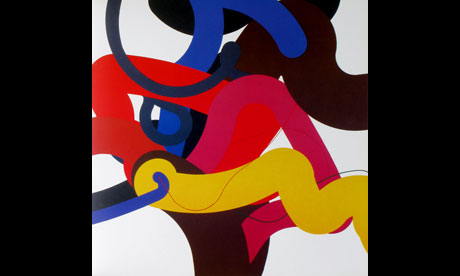
Zdenek Sykora in his studio in Louny, Czech Republic.
Sykora was born in Louny, a town in northern Bohemia, which played a dominant role in his life even while he was immersed in the cultural life of Prague. Although his education was interrupted by the German occupation and the onset of the second world war, in 1945 he became a student at the art education department of Charles University, Prague, where he was a first-class hockey player. He soon began a long teaching career.

Zdenek Sykora's Lines No 216, 2003
Sykora's early work, up to the late 1950s, hurtled in no particular order through the history of modern art, from realism, impressionism and post-impressionism to expressionism, cubism and surrealism. Much of his painting was based on the varied, often mountainous landscape around Louny, especially the river Ohre and the valleys beyond the village of Cítoliby, which appeared in his first individual exhibition at the Ales Hall in Prague (1952). Seven years later his artistic development was accelerated by his encounter with Henri Matisse's pictures at the Hermitage in Leningrad, now St Petersburg. The resulting transition from naturalism to abstraction can be seen most clearly in the remarkable Gardens series, which culminated in the high stylisation of Garden/Composition (1961).
During this era of thriving avant-garde activity, Sykora was at the heart of Krizovatka (Crossroads), a disparate group of artists who gravitated around the poet and painter Jiri Kolar at the Slavia Cafe in Prague. Sykora's dazzling, grid-like compositions, consisting of black-and-white geometric forms, included his celebrated Structure paintings, as well as a fire-curtain in Louny theatre (1963) that only survives as a photograph hanging in the foyer.
A year later his collaboration with the mathematician Jaroslav Blazek led to his first computer-assisted works, which explored different combinations of abstract elements in accordance with predetermined rules. While they have a passing similarity to Op art in western Europe and America, their rigorous mathematical method was unique to Sykora. Such striking innovation attracted international attention, leading in 1965 to Sykora's participation in an exhibition in Genoa, followed by other group shows in Germany and Yugoslavia. This period of success, in which he was also appointed an associate professor at Charles University, culminated in some major decorative projects in Prague during the late 1960s. These included a ceramic wall, now incorporated into a cafe, on Jindrisska Street and, most spectacularly, the glass tile exteriors of the towering ventilation flues above the Letná road tunnel.
Political repression in Czechoslovakia during the 1970s did not hinder Sykora's experimentation, although he also returned to producing landscape pictures of his native region, as well as images of the Baltic island of Rügen in East Germany. More significantly, he developed an idiom characterised by dense clusters of interwoven, curving lines, in which every aspect of the composition, from the intense hues to the thickness, direction and length of each element, was determined by a computer. The procedure, which combined mathematical systems with a quality of randomness, reflected a quasi-scientific understanding of reality. As Sykora himself said: "The more I wish my paintings to be just what they are, the more they are everything."
The metaphysical dimension, reflected in such monumental pieces as Lines No 24, The Last Judgement (1983-84) as well as in collaborations with his wife Lenka, gave Sykora's work an enduring appeal. After the fall of the Communist regime, he received considerable exposure both at home and abroad, participating, for example, in the seminal exhibition Europa, Europa, celebrating a century of the avant garde in central and eastern Europe, held in Bonn in 1994, before becoming the subject of Jaroslav Brabec's hour-long documentary film for a Europeans series on Czech television (2001).
In this final period Sy´kora also produced some ambitious linear designs for architectural spaces, including the entrance hall of the new air traffic control centre in Jenec, outside Prague, in 2005. Yet more international accolades, including the acquisition of Lines No 24, The Last Judgement, by the Pompidou Centre in Paris (2007), completed a career of considerable rigour and integrity. He is survived by Lenka.
• Zdenek Sykora, artist, born 3 February 1920; died 12 July 2011
No comments:
Post a Comment